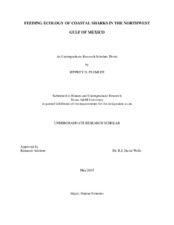| dc.description.abstract | The feeding ecology of three coastal shark species consisting of Atlantic Sharpnose (Rhizoprionodon terraenovae), Bonnethead (Sphyrna tiburo), and Atlantic Blacktip (Carcharhinus limbatus) was examined in the northwest Gulf of Mexico (GOM). A total of 601 (305 R. terraenovae, 239 S. tiburo, and 57 C. limbatus) sharks were collected through the recreational fishery offshore Galveston, Texas over 2013 and 2014. Stomach contents were examined for all individuals and quantified for short-term diet information (days) and stable isotopes of carbon (δ13C), nitrogen (δ15N), and sulfur (δ34S) in muscle tissue were analyzed for a subset of samples to examine longer term (weeks to months) feeding patterns. Both C. limbatus and R. terraenovae stomach contents primarily consisted of teleost fish with % index of relative importance (IRIs) of 91.16 and 98.95%, respectively. Primary prey categories for R. terraenovae included unidentified Teleostei (87.40 %IRI), Panaeidae (3.56 %IRI), and Tuthoidea (2.92 % IRI). Dominant prey in C. limbatus consisted of Unidentified Teleostei (88.52 %IRI) and Micropogonias undulatus (7.46 %IRI), additional non-teleost fish prey categories including Crustacea and Cephalopoda accounted for 1.15 %IRI. S. tiburo had a diet primarily of crustaceans (87.20 % IRI), the top three contributors were unidentified Brachyura (48.91 %IRI), Callinectes sapidus (18.06 %IRI), and C. similis (3.32 % IRI). Stable isotope results revealed similar trends as the stomach contents. Mean δ13C was significantly enriched for S. tiburo (-16.84 ‰) relative to the other two species, which had similar mean δ13C (R. terraenovae -17.07 ‰ and C. limbatus -17.06 ‰). Mean δ15N was significantly enriched for C. limbatus (16.64 ‰) and similar between R. terraenovae (15.94 ‰) and S. tiburo (15.90 ‰). δ34S was a useful tracer for benthic invertebrate consumption consisting of significantly depleted values for S. tiburo (15.45 ‰), relative to R. terraenovae (16.01 ‰) and C. limbatus (16.30 ‰). Collectively, both stomach contents and stable isotopes support unique feeding strategies of three common shark species that occupy similar habitats in the northwestern GOM. | en |


